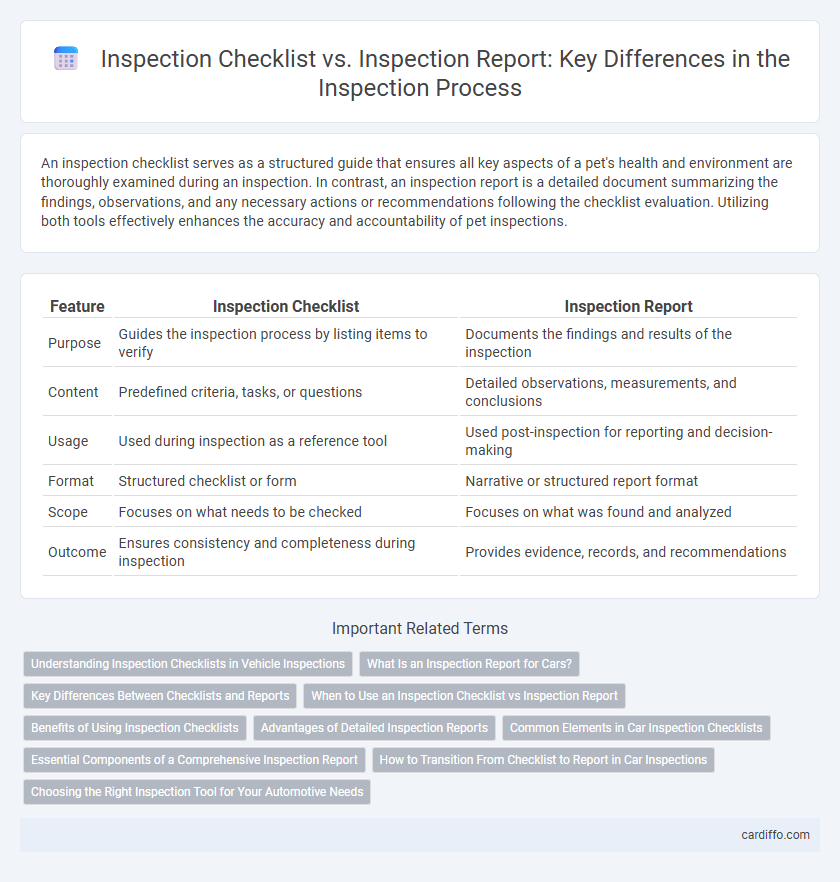An inspection checklist serves as a structured guide that ensures all key aspects of a pet's health and environment are thoroughly examined during an inspection. In contrast, an inspection report is a detailed document summarizing the findings, observations, and any necessary actions or recommendations following the checklist evaluation. Utilizing both tools effectively enhances the accuracy and accountability of pet inspections.
Table of Comparison
| Feature | Inspection Checklist | Inspection Report |
|---|---|---|
| Purpose | Guides the inspection process by listing items to verify | Documents the findings and results of the inspection |
| Content | Predefined criteria, tasks, or questions | Detailed observations, measurements, and conclusions |
| Usage | Used during inspection as a reference tool | Used post-inspection for reporting and decision-making |
| Format | Structured checklist or form | Narrative or structured report format |
| Scope | Focuses on what needs to be checked | Focuses on what was found and analyzed |
| Outcome | Ensures consistency and completeness during inspection | Provides evidence, records, and recommendations |
Understanding Inspection Checklists in Vehicle Inspections
Inspection checklists in vehicle inspections serve as standardized tools that ensure all critical components, such as brakes, tires, lights, and fluid levels, are systematically evaluated for safety and functionality. These checklists streamline the inspection process by providing a clear, itemized sequence of tasks for inspectors, minimizing the risk of oversight and enhancing accuracy. Unlike inspection reports, which document the results and findings post-examination, checklists act as a proactive guide to facilitate thorough and consistent assessments during vehicle inspections.
What Is an Inspection Report for Cars?
An inspection report for cars provides a detailed evaluation of a vehicle's condition after a thorough examination, documenting all findings such as mechanical issues, safety concerns, and wear and tear. It serves as an essential record for buyers, sellers, and mechanics to assess the car's current state and make informed decisions about repairs or purchases. Unlike an inspection checklist, which lists items to be reviewed, the inspection report summarizes the actual results and recommendations based on the inspection.
Key Differences Between Checklists and Reports
Inspection checklists serve as structured tools containing predefined criteria to guide inspectors through systematic evaluations, ensuring consistency and thoroughness during the inspection process. Inspection reports compile detailed findings, observations, and conclusions derived from the checklist and onsite assessments, providing a comprehensive documentation of the inspection outcome. Key differences include the checklist's role as a preparatory and procedural aid, while the report functions as a formal record communicating results, issues identified, and recommendations.
When to Use an Inspection Checklist vs Inspection Report
An inspection checklist is essential during the initial stages of assessment to ensure all specified criteria and components are systematically evaluated, improving accuracy and consistency. An inspection report is used after completing the inspection to document findings, observations, and any deviations detected, serving as an official record for stakeholders. Choose a checklist to guide thorough data collection and an inspection report to communicate results effectively for decision-making and compliance.
Benefits of Using Inspection Checklists
Inspection checklists enhance accuracy by providing a structured framework that ensures all critical components are evaluated consistently during inspections. They improve efficiency by reducing oversight errors and standardizing the inspection process across different teams and projects. Using inspection checklists also facilitates clear documentation and supports compliance with regulatory standards, making it easier to track issues and implement corrective actions effectively.
Advantages of Detailed Inspection Reports
Detailed inspection reports provide comprehensive documentation of findings, enabling clearer communication and better decision-making for maintenance or compliance actions. They capture precise observations, photographic evidence, and specific measurements that go beyond the checklist's basic verification. This level of detail enhances traceability, accountability, and facilitates trend analysis for ongoing quality improvement.
Common Elements in Car Inspection Checklists
Car inspection checklists and inspection reports share common elements such as vehicle identification details, including make, model, and VIN, to ensure accurate documentation. Both include comprehensive assessments of critical systems like brakes, tires, lights, and engine components to verify safety and functionality. Documentation of observed defects or maintenance needs is recorded in both formats to provide a clear basis for repair decisions and vehicle status.
Essential Components of a Comprehensive Inspection Report
A comprehensive inspection report includes detailed findings, photographic evidence, and clear documentation of observed issues, which surpass the basic itemized tasks of an inspection checklist. Essential components consist of identifiable object descriptions, condition assessments, compliance status, and recommendations for corrective actions. This thorough approach ensures transparency, accountability, and actionable insights for stakeholders.
How to Transition From Checklist to Report in Car Inspections
Transitioning from an inspection checklist to a detailed inspection report in car inspections involves documenting each checklist item with comprehensive notes, photographs, and findings to provide clear evidence of vehicle condition. By enhancing the checklist's bullet points into narrative descriptions, inspectors create a thorough report that supports maintenance decisions and legal compliance. Integrating digital tools allows seamless extraction of checklist data into customizable report templates, improving accuracy and efficiency in reporting car inspections.
Choosing the Right Inspection Tool for Your Automotive Needs
Inspection checklists ensure a systematic and thorough evaluation by listing all critical vehicle components and criteria to verify during an inspection. Inspection reports document the findings, providing detailed evidence and recommendations based on the checklist outcomes for informed decision-making. Selecting the right inspection tool involves assessing whether the process benefits more from structured guidance with a checklist or comprehensive documentation through a detailed report to enhance automotive maintenance and safety.
Inspection Checklist vs Inspection Report Infographic

 cardiffo.com
cardiffo.com